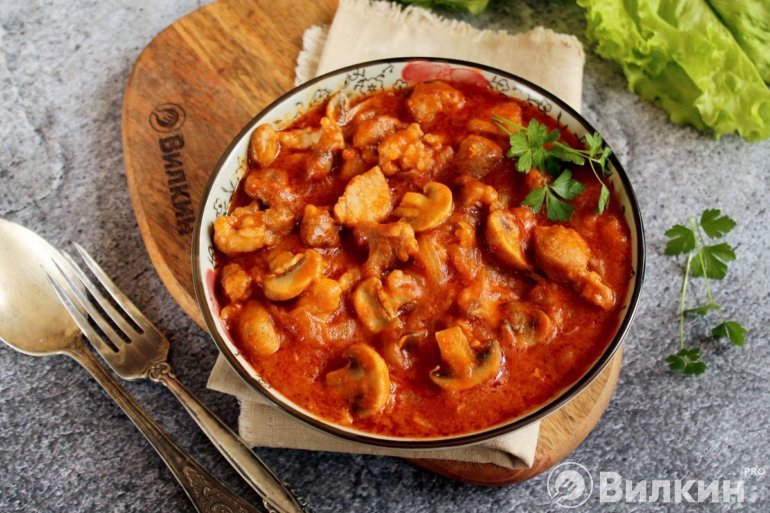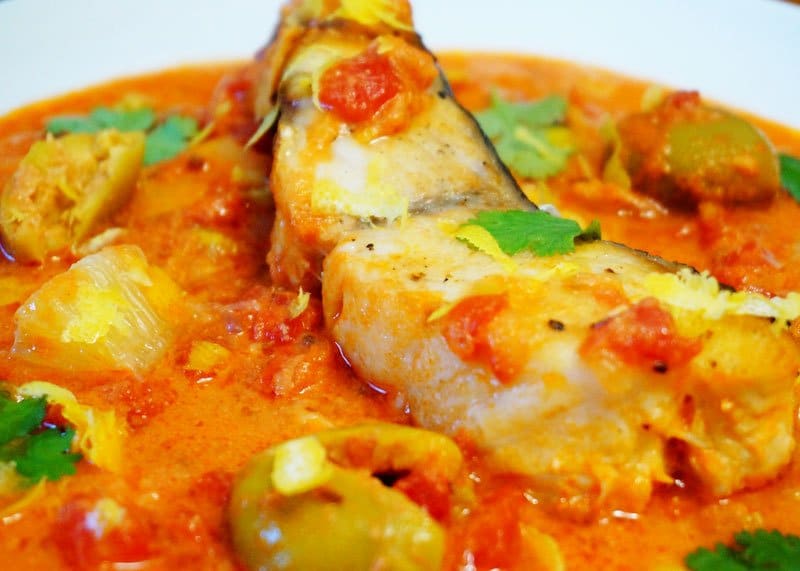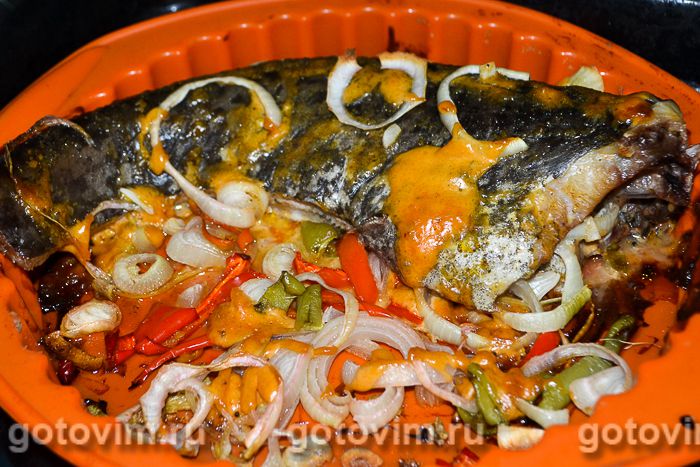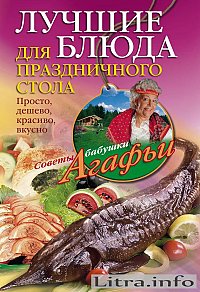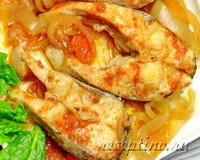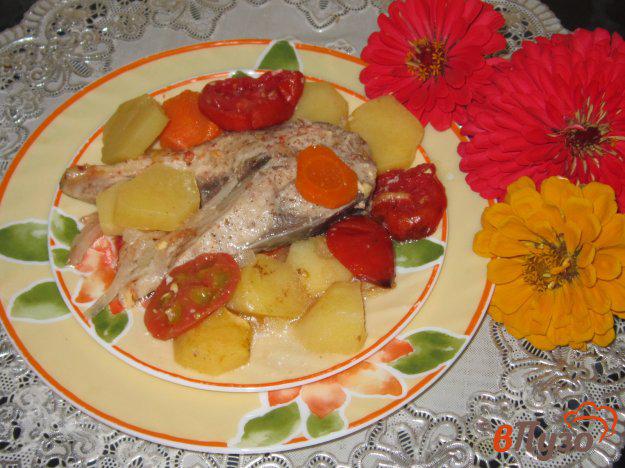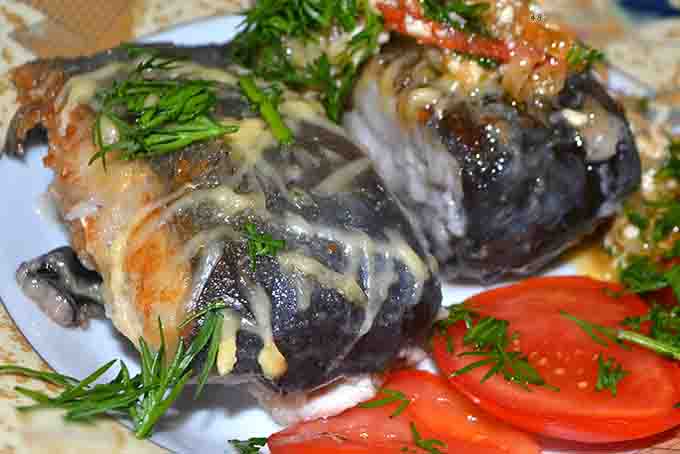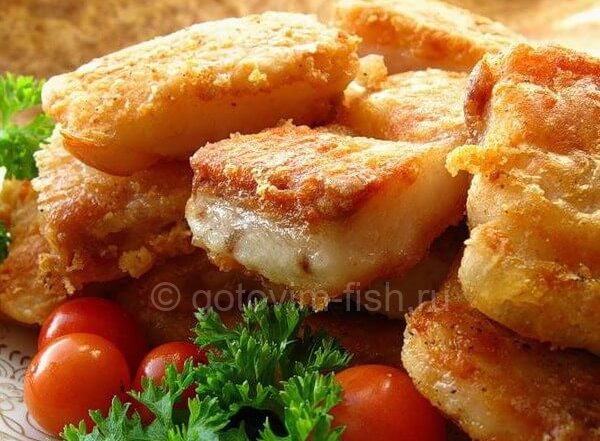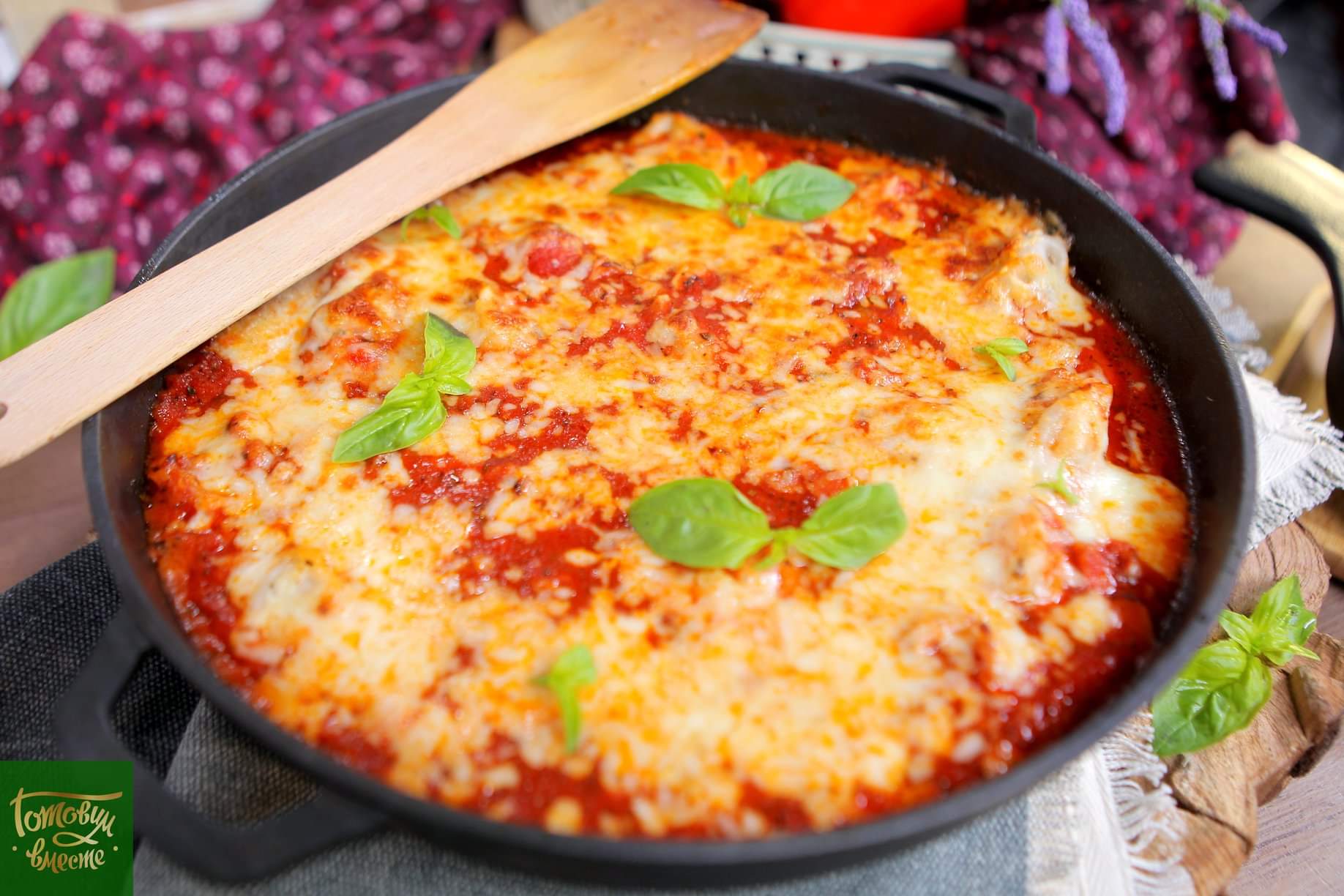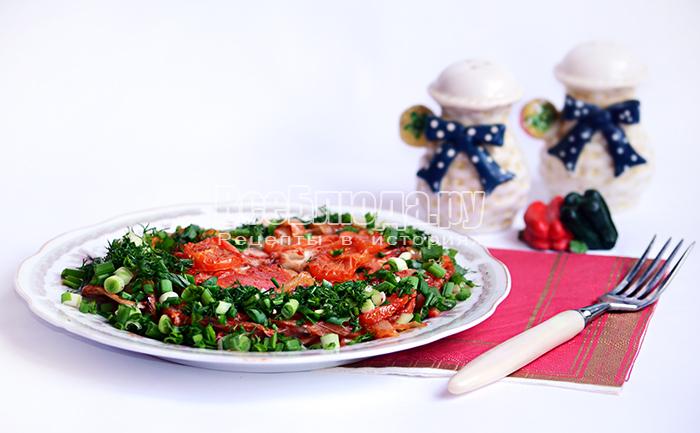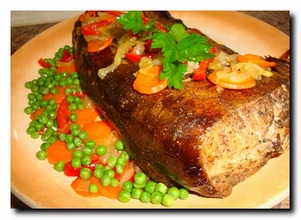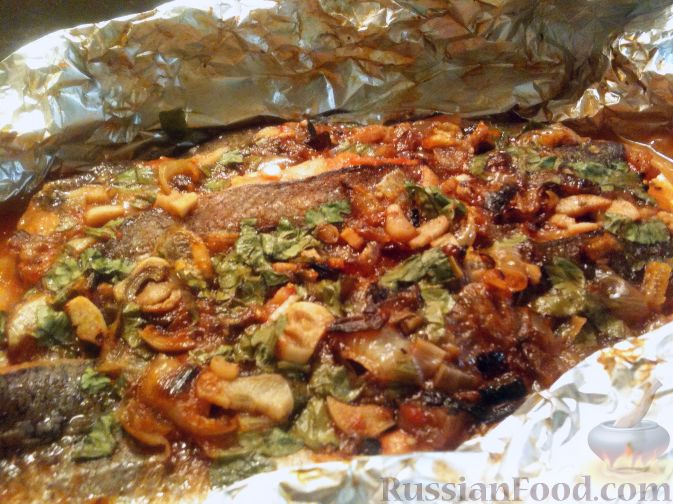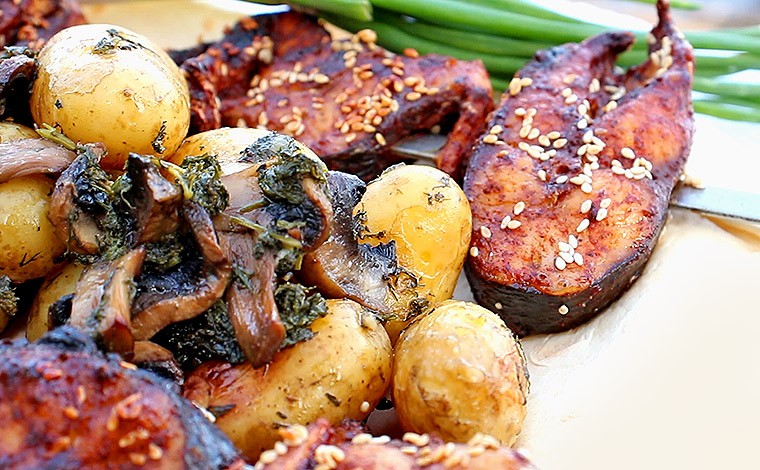Ingredients for Fish in Tomato Sauce:
-
A fish
(whole head, for example mullet)
—
1 kg -
A tomato
(large, ripe, or in its own juice)
—
700 g -
Onion
—
1 PC -
Garlic
—
3 tooth. -
Olive oil
-
Salt
(taste)
-
Seasoning
("Italian herbs" or oregano)
—
1 tsp -
Greens
(fresh - dill, parsley, green onions)
-
Black pepper
(taste)
Cooking time: 50 minutes
Servings: 3
Nutritional and energy value:
| Ready meals | |||
|
kcal
1164.7 kcal |
proteins
184.9 g |
fats
21.8 g |
carbohydrates
58.6 g |
| Portions | |||
| kcal 388.2 kcal | proteins61.6 g | fat7.3 g | carbohydrates 19.5 g |
| 100 g dish | |||
| kcal 63 kcal | proteins 10 g | fats1.2 g | carbohydrates 3.2 g |
Recipe "Fish in Tomato Sauce":

First you need to make tomato sauce. To do this, peel the tomatoes from thin peels and grind them in a blender.
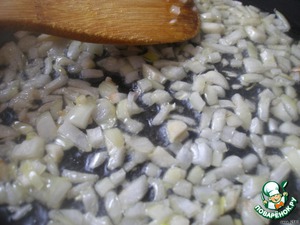
Heat olive oil in a frying pan. Fry finely chopped onion and finely chopped garlic until slightly golden brown.

Add chopped tomatoes (or tomatoes in their own juice), salt, pepper and Italian herbs. Simmer - cook for 8-10 minutes over low heat.

Clean the fish, gut, remove the gills. If your fish is small, then put it in a pan, directly in the tomato sauce and fry and steam under the lid until tender, pouring over the tomato. If the fish is slightly larger than the frying pan, then take a heat-resistant dish, brush with olive oil and put the whole fish there.

Spread the tomato sauce over the fish, cover with foil and place in the oven for 30 minutes.

Put the cooked fish whole on a dish and garnish with herbs. After the guests have gathered at the table, divide the fish into portions.
The Jewish New Year of Rosh Hashanah begins with a 10-day holiday that falls in September or October. On the eve of Rosh Hashanah, at the festive table before the start of the meal, it is customary to dip a piece of challah in honey. After the challah is eaten, each participant is given a piece of apple dipped in honey, and it is said: L \ 'shana tovah tikatevu ("May it be kind and sweet this year").
Different ethnic groups have different customs for celebrating the new year. The Sephardim serve the whole fish, along with the head, which symbolizes a year rich in wisdom, with Israel at the head of the nation, not at the tail - a leader, not an oppressed. Wholeness symbolizes the full coming year, and the head symbolizes the wisdom that is asked to be bestowed on them.
On the festive table there should be nothing bitter, sour or salty (with the exception of salt), as well as nuts, the name of which in Hebrew is consonant with the word "sin".
Each type of food has a symbolic meaning. These are: round challah, apples, fish head, dates, carrots, pomegranates, beets and pumpkin. The meal begins with challah, slices of which are dipped in honey, and then apples, slices of which are also dipped in honey - a symbol of our hope for a "good and sweet" year. The head of the fish is a symbol of the realization that the Most High, blessed is He - the Head of the Universe, the King over the kings of kings. Pisces never sleep - so the Almighty never sleeps, taking care of His beloved people. The fish's head symbolizes the desire to be "the head, not the tail." Fish is a symbol of fertility and blessing. “We eat it so that“ we become as numerous on earth as fish in the sea! ” Fish were the only living creatures that did not sin, and therefore were not destroyed by the Flood - the fish on the table symbolizes the desire to be clean from sins.
Here is another tradition of celebrating the New Year! Happy Holidays!
Recipe "Catfish with tomato-mushroom sauce":

Gut the catfish, rinse, cut into steaks about 2 cm wide (I put my head aside for the fish soup).Rub with salt, sprinkle with black pepper and tarragon, you can sprinkle lightly with lemon juice (for some reason I didn't have a lemon today  ) and put the catfish in a fireproof mold
) and put the catfish in a fireproof mold

In the meantime, let's take care of the mushrooms: the mushrooms must be washed, chopped, put in a frying pan and simmered in a little water (5 minutes), then drain the resulting mushroom (it will be useful to us in the future). Add onion chopped in half rings, salt, add basil, oregano, a little ground black pepper and fry until the onion is transparent.

Now add ketchup, mushroom broth, pickled cucumbers grated on a medium grater, sugar and simmer for another 5 minutes.

Pour our fish with the resulting sauce and send it to an oven preheated to 180-200 degrees for 40 minutes.

That's all, the fish is ready, you can enjoy it!
Bon Appetit! 
Fried catfish in tomato sauce with olives and Maghreb tahini

The Maghreb cuisine is formed from the culinary traditions of a large region stretching along the Mediterranean coast in northwestern Africa and includes countries such as Algeria, Libya, Morocco (formerly Mauritania) and Tunisia.
All of these countries have always been distinguished by considerable geographic, economic and cultural diversity, which has left a noticeable imprint on their gastronomic preferences and culinary style.
Their formation at different times was significantly influenced by the cultural and culinary traditions of Andalusia, Phenicia and the Berber tribes.
In addition, France and Italy significantly influenced Algerian and Tunisian cuisine, and the Kingdom of Numidia (now the territory of modern Algeria) had a certain impact on Moroccan cuisine.
The main components that determine the culinary features of the cuisine of the countries of the Maghreb area have always been couscous, fish, seafood, lamb and beef, figs, almonds, olives, all kinds of vegetables and fruits. Since the population of this entire region is mainly composed of Muslims, halal meat is preferred here.
Almost all dishes are seasoned with spices, of which the most popular are paprika, cumin, ginger, cinnamon and saffron. Mint, parsley and cilantro are almost always present in dishes. Seasonings such as time el-hanut, baharat, harissa and tahini are traditional. Sun-dried plums and tomatoes, nuts and spices are commonly used in food in large quantities.
Lemons marinated in salt or "l'hamd mrakad", as well as sun-dried olives in oil are a distinctive feature of the Maghreb cuisine.
The most famous Maghreb dish in Europe and America is couscous, made from semolina durum wheat flour.
Also well known in Europe - including here - the Berber hajin, although it is prepared in different ways. In Tunisia, for example, in the hajin, dishes are baked, and in Morocco, they are mainly stewed.
It would be unfair not to remember the marshmallow - a world-famous Arab-Andalusian delicacy.
I have written enough about catfish in past posts. Those who read us know about this fish no less than I do, and maybe more. Nevertheless, I never cease to admire this fish, wonderful in every respect.
In a sense, catfish, like lard, is a symbol of the national identity of many Ukrainians, especially those of them who inhabit the south of our large and generous country with natural resources.
If a question arises in front of me and Yulia, which fish to choose for our new dish, so that it is tender, rather fatty, juicy and sweet and, with all this, easily and quickly cooked, then this, of course, catfish or carp - here we have no doubts.
This time we cooked Maghreb-style catfish with a rich and aromatic Moroccan-style sauce of tahini, tomatoes, lemons and olives.
(for 6 servings)
Ingredients:
- 1.2 kg catfish fillet, cut into portions
- 1 teaspoon fresh ginger, peeled and grated
- 400 tomatoes canned in their own juice
- 1 large lemon, peeled and chopped
- Zest from one lemon
- 7-8 large green olives, crushed with a knife
- 1 liter fish broth
- Half a bunch of cilantro (for decoration)
- 30 ml light honey
- Half a teaspoon of cumin
- 1/2 teaspoon coriander
- Half a cinnamon stick, coarsely crushed in a mortar
- 5-6 juniper berries, coarsely crushed in a mortar
- 1 tablespoon tahini
- 60 ml olive oil infused with garlic
- Olive oil
- Salt and pepper
Preparation:
- We take olive oil infused with garlic, add ginger and all other spices to it, fry in a pan until a strong aroma of spices appears (about 2-3 minutes).
- Add tahini and pre-crushed tomatoes to the mixture, cook for a couple of minutes. Then pour in the fish broth, and also add lemon, zest, olives and honey. Salt.
Simmer for about 20 minutes, until the sauce thickens slightly.
- Salt and pepper the pieces of catfish. Fry them in a large skillet in olive oil for 5-6 minutes on each side, until golden brown.
- When the fish is ready, place the slices in the tomato sauce and simmer under a closed lid for about 5 minutes. Then we immediately serve.
- Decorate with cilantro sprigs before serving.
Composition Canned catfish in tomato sauce
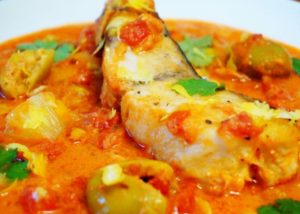
Full chemical composition of the product Canned catfish in tomato sauce, macronutrients and trace elements, nutritional value, vitamins and minerals.
The recommended daily allowance is the average amount of consumption of essential nutrients to maintain the body in a healthy state, indicated in grams and percent.
Daily use allows us to regularly receive the substances we need. Some substances are allowed to be consumed more frequently.
table
| Calorie content | 126 mg | |
| Protein | 12.9 g | |
| Carbohydrates | 4 g | |
| Fats | 6.3 g | |
| Vitamin B3 | 1.9 mg | 15.059 mg |
| Vitamin B2 | 0.07 mg | 1.329 mg |
| Vitamin PP (NE) | 4.1 mg | 15.059 mg |
| Vitamin B1 | 0.03 mg | 1.159 mg |
| Vitamin E (TE) | 1.7 mg | 10.882 mg |
| Vitamin C | 69.118 mg | |
| Provitamin A | 0.3 mg | 5 mg |
| Vitamin A (RE) | 0.058 mg | 0.753 mg |
| Vitamin B5 | 3.794 mg | |
| Vitamin B6 | 1.512 mg | |
| Vitamin B9 | 0.286 mg | |
| Vitamin H | 0.034 mg | |
| Vitamin A | 8 mcg | 752.9 μg |
| Vitamin E | 15 mg | |
| Vitamin B12 | 3 μg | |
| Vitamin B4 | 500 mg | |
| Vitamin D | 0.011 mg | |
| Vitamin K | 0.085 mg | |
| Calcium | 384 mg | 987.5 mg |
| Magnesium | 72 mg | 276.177 mg |
| Sodium | 650 mg | 948.824 mg |
| Potassium | 386 mg | 1807.143 mg |
| Phosphorus | 437 mg | 852.941 mg |
| Sulfur | 129 mg | 1000 mg |
| Silicon | 30 mg | |
| Iron | 1 mg | 13.75 mg |
| Chlorine | 165 mg | 2300 mg |
| Copper | 0.806 mg | |
| Manganese | 2 mg | |
| Fluorine | 0.43 mg | 3 mg |
| Boron | 1.4 mg | |
| Aluminum | 40 mg | |
| Titanium | 0.85 mg | |
| Strontium | 1.5 mg | |
| Iodine | 0.131 mg | |
| Zinc | 0.7 mg | 9.706 mg |
| Chromium | 0.055 mg | 0.034 mg |
| Molybdenum | 4 μg | 70 mcg |
| Vanadium | 0.01 mg | |
| Cobalt | 0.1 mg | |
| Nickel | 6 μg | 100 mcg |
| Rubidium | 0.2 mg | |
| Lithium | 0.2 mg | |
| Selenium | 0.04 mg | |
| Tin | 0.7 mg | |
| Zirconium | 0.5 mg | |
| Alimentary fiber | 800 mg | |
| Organic acids | 400 mg | |
| Water | 72.4 g | |
| Mono- and disaccharides | 2.7 g | |
| Ash | 3.2 g | |
| Alcohol | ||
| Starch | 1.3 g | |
| Saturated fatty acids | 1.2 g | |
| Cholesterol | 56 mg | |
| Unsaturated fatty acids |
This table shows the average norms of elements for an adult.
What's more useful? Compare Canned Catfish in Tomato Sauce with other foods:
In order to compose the most suitable and balanced diet, compare the composition of the product Canned catfish in tomato sauce with other products, use the filter. Compare the content of vitamins and minerals with other foods.







